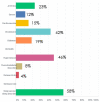Psychosocial Work Stress and Occupational Stressors in Emergency Medical Services
- PMID: 37046903
- PMCID: PMC10093884
- DOI: 10.3390/healthcare11070976
Psychosocial Work Stress and Occupational Stressors in Emergency Medical Services
Abstract
Emergency medical service (EMS) professionals often experience work stress, which escalated during COVID-19. High job demand in the EMS profession may lead to progressive decline in physical and mental health. We investigated the prevalence of psychosocial job stress in the three levels of EMS: basic, advanced, and paramedic, before and during the COVID-19 pandemic. EMS professionals (n = 36) were recruited from EMS agencies following the Institutional Review Board approval. Participants took surveys on demographics, personal characteristics, chronic diseases, and work schedules. Job stress indicators, namely the effort-reward ratio (ERR) and overcommitment (OC), were evaluated from survey questionnaires using the effort-reward imbalance model. Associations of job stress indicators with age, sex, body mass index, and working conditions were measured by logistic regression. Psychosocial work stress was prevalent with effort reward ratio > 1 in 83% of participants and overcommitment scores > 13 in 89% of participants. Age, body mass index, and work hours showed strong associations with ERR and OC scores. The investigation findings suggested that a psychosocial work environment is prevalent among EMS, as revealed by high ERR, OC, and their correlation with sleep apnea in rotating shift employees. Appropriate interventions may be helpful in reducing psychosocial work stress in EMS professionals.
Keywords: effort reward imbalance; emergency medical services; overcommitment; psychosocial job stress; rotating shift; sleep apnea.
Conflict of interest statement
The authors declare no conflict of interest. The funders had no role in the design of the study; in the collection, analyses, or interpretation of data; in the writing of the manuscript; or in the decision to publish the results.
Figures





References
-
- Neale A.V. Work stress in emergency medical technicians. J. Occup. Med. 1991;33:991–997. - PubMed
Grants and funding
LinkOut - more resources
Full Text Sources

